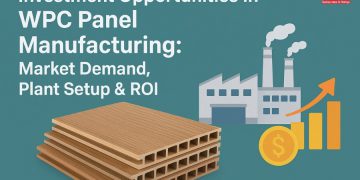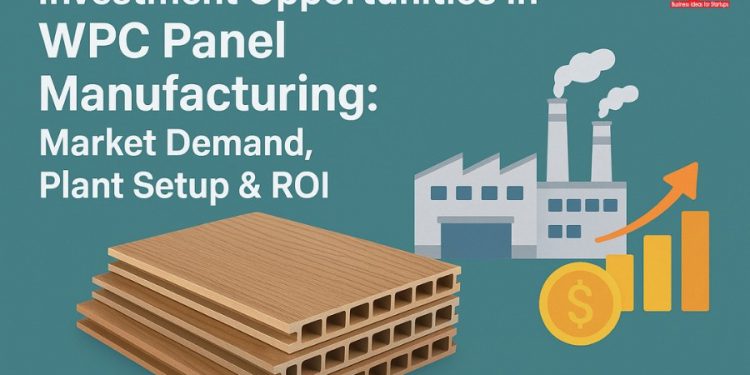Where traditionally construction materials claim to durability, aesthetic value and eco-friendliness, WPC panels (Wood-Plastic Composite Panels) have come up as revolutionary products. WPC panels combine the unique attributes of wood and the strength of thermoplastics, extending its application to construction, furniture and interior design. The growing demand for eco-friendly alternatives to plywood, MDF, solid wood and add-value materials presents a lucrative investment opportunity in the WPC panel manufacturing business.
In conjunction with rapid urbanization and a shift towards green building materials in real estate activity, demand is set to grow in the long term. For entrepreneurs, startups and even existing players in the the building materials segment, there is ample opportunity not just to take advantage of shifting conditions, but also to work towards forestain development goals by shifting into the WPC panel manufacturing business.
In this article, we delve into the opportunities in the manufacturing of WPC panels, analyzing market conditions, plant configuration, raw materials required, technologies available, economics, and ROI. We explore how Niir Project Consultancy Services (NPCS) can help you with supporting your business with comprehensive planning and successfully feasibility studies.
What are WPC Panels?
WPC Panels also called Wood-Plastic Composite Panels are composite materials that are made with a blend of thermoplastics such as PVC, PE, or PP with wood flour or wood fibers, sometimes with supplementary additives such as stabilizers, colorants, and lubricants. The final product looks and feels like wood, but performs much better in water resistance, termite resistance, fire retardancy, and dimensional stability.
WPC panels are used extensively in:
- Furnishings like desks, tables, and other movable furniture
- Kitchens for wardrobes and cabinets
- Wall cladding for decoration
- Partitions and door frames
- Interior panels, false ceilings, and more
- Outdoor decking and fencing for thicker grades
WPC panels are a preferred choice to conventional wood panels for urban households, commercial interiors, and green buildings due to their low maintenance, long life, and non-toxic composition.
Related: How to Set Up a Solar Panel Manufacturing Plant in India
Market Demand and Growth Drivers
The Indian market for WPC panels is growing at a CAGR of over 15% with a projected 6,000 crore rupees by 2030. The global WPC market expects to go beyond USD 9 billion globally before the end of the decade. There are many reasons that drive the strong demand such as:
- Cutting down forest wood in many places and increasing environmental concern about deforestation.
- Government encouragement for eco-friendly construction with LEED and GRIHA certification.
- Rise in the adoption of modular interiors as a result of a ready- to- use deployment option in urban areas.
- Plywood’s waning popularity because of warping and termite damage is exacerbated by difficult maintenance.
- Retail and hospitality growth that require sophisticated and reliable design materials.
- Policies on affordable housing and smart cities are creating a surge in bulk requirements.
- There’s a growing preference for WPC among customers due to its low life-cycle costs, ease and speed of installation, aesthetic versatility, and superior performance in high-moisture areas such as kitchens and bathrooms.
WPC Products Manufactured
Although this article will discuss WPC panels, it is equally important to mention that other products a typical WPC plant can produce include:
- WPC Boards (furniture and paneling grade plywood substitutes)
- WPC Sheets (partitions and signage material)
- WPC Doors and Frames
- WPC Foam Boards (light duty applications)
- WPC Decking and Railings (For use outside)
The broad range of products that can be offered makes WPC manufacturing very scalable, since new SKUs can be added as required without extensive infrastructure changes to the plant.
Components for WPC Panel Manufacturing
The wood-plastic composite manufacturing process requires a well-balanced blend of polymers and wood derivatives. The principal components of the composites include:
- Wood Flour/Wood Powder: Obtained from the recycle of wood, wood chips, or sawdust. It provides the natural appearance and feel.
- Plastic Resin (PVC, PE, PP): Structural strength, water impermeability, and adhesion is accomplished with the use of either virgin or recycled plastic.
- Calcium Carbonate (CaCO₃): Used as a filler to enhance workability and lower cost.
- Stabilizers and Lubricants: Aid in the prevention of thermal degradation while allowing for smoother extrusion of the material.
- Color Pigments and UV Stabilizers: Improve aesthetics as well as the life of materials.
All components are precisely measured, mixed, compounded, and extruded to make WPC panels.
Manufacturing of WPC Panels
WPC panel manufacturing undergoes a number of accurate and tightly monitored procedures to obtain a certain level of quality and consistency:
- Raw Material Mixing: The polymer granules, additives, and wood powder are blended by high intensity mixers which guarantees that a heterogeneous blend is formed.
- Compounding: The batch will be further blended with heat before being compounded using a twin-screw extruder. This step enhances the distribution of wood fibers within the plastic matrix.
- Extrusion Molding: The mixture is then entered into an extruder where it is converted into sheets using specialized molds. The extrusion die settings can be changed to achieve specific length and width requirements.
- Cooling and Calibration: Calibration and cooling are performed on the extruded sheets to maintain the shape and size derived from the die.
- Cutting and Finishing: The panels may undergo additional processes like polishing, decorating, or sanding before being cut to standard or tailored size.
- Quality Testing and Packing: The panels undergo testing against a set dimensional standard for density, flexural strength, water absorption, and overall stability, prior to being packed for transport.
NPCS helps in primary and secondary machine installation, creation of the plant’s blueprints, design, management of production line, and process automation for WPC panels.
Related: Start the Wood Plastic Composite (WPC) Manufacturing Business. Best Investment Opportunities for entrepreneurs.
Setting Up a WPC Panel Manufacturing Plant: Infrastructure and Investment
The following elements are required in aid of the plant establishment:
- Land and Building: Approximately 10,000 to 20,000 square ft. according to production capability and growth expectations.
- Machinery: Consists of a conveying system, PC control system, raw material silos, blowers, heating and cooling units, and storage tanks.
- Utilities: Power supply (approx. 200–300 kVA for medium plant), water intake, ETP if needed.
- Manpower: Technologically trained operators, engineers, QC personnel, packers, and a marketing team.
Based on Niir Project Consultancy Services (NPCS) feasibility reports, a medium-scale plant with a capacity of 1,000–1,500 metric tonnes per annum can be established for an estimated investment cost of ₹3.5 crore to ₹6 crore, sourced depending on the degree of automation and quality of machinery, whether imported or indigenous.
NPCS also aids entrepreneurs with detailed vendor lists, factory blueprints, and even civil layout drawings aimed at maximizing space efficiency.
Economic Prospects and ROI
WPC panel manufacturing is a high-margin business and adds value due to the low cost of raw materials. Here’s a brief financial overview based on NPCS estimates for a 1,200 TPA capacity plant:
- Capital Investment: ₹5 crore, with expenditure on machinery and working capital included
- Annual Turnover: ₹9–11 crore
- Gross Margin: 25–30%
- Earnings before Interest, Taxes, Depreciation, and Amortization: ₹2.2–2.8 crore/year
- Payback Period: 2.5 to 3 years
- Return on Investment: 20% to 25% after stabilization
NPCS estimates indicate that a marketing-focused plant stands to hit full capacity utilization in 12-18 months due to the increasing demand for WPC in constructions and furniture. Margins can also be improved by increasing laminated or printed fire-retardant variants.
Marketplace Division and Customer Relationship
Potential clients include,
- Construction and contracting firms
- Commercial office interiors and Corporate office open spaces furnishing
- Specialized and Government funded school, departmental office and public building procurement for elementary education facilities, institutional edifices, and administrative complexes integrated with selective governmental services.
Export potential also exists in the Middle East, South East Asia, and Africa since their climatic conditions are suitable for moisture resistant and termite proof materials like WPC.
NPCS provides buyer databases, marketing, and competition analysis to reduce client acquisition costs.
Relay Nature-Granted Instructions and Endorse Compliant Philosophy
Among the exceptional benefits of WPC manufacturing, the environmental friendliness stands out. This is favorable for several policies such as:
- Encouragement of concrete in lieu of forest products by the Ministry of Environment and Forests—ring fencing benefits of taxation on green construction items.
- Granting support to small and medium enterprises under the Atmanirbhar Bharat scheme.
- No formaldehyde emissions from WPC materials, unlike MDF and particle boards, along with supporting plastic waste recycling enables NPCS clients to meet eco-friendly guidelines. NPCS assists companies in obtaining EIA clearance, factory act compliance, and registering with the labour office.
How NPCS Supports Your WPC Business Vision
Niir Project Consultancy Services (NPCS) is a leading industrial consulting firm in India with decades of experience in feasibility reporting, project planning, and business consulting.
For WPC panel projects, NPCS offers:
- Detailed Techno-Economic Feasibility Reports (TEFRs)
- Raw material and supplier directory
- Equipment and plant layout plans
- Financial modeling with cash flow and breakeven charts
- Market entry and branding strategy
- Support with funding, loan documentation, and government scheme applications
Whether you’re a first-time entrepreneur or an existing plywood manufacturer looking to diversify, NPCS can guide your investment journey from concept to commissioning.
Conclusion: WPC Panel Manufacturing – A Sustainable & Profitable Business for the Future
The future of construction and interiors lies in materials that are sustainable, durable, and design-flexible. WPC panels meet all these requirements and more. As the industry shifts away from traditional wood-based materials, the demand for WPC will continue to soar.
Setting up a WPC panel manufacturing unit not only offers strong profitability but also contributes to reducing deforestation and plastic waste. With the right mix of technology, branding, and operational planning—and with expert guidance from Niir Project Consultancy Services—you can build a scalable, future-ready, and high-margin business in the WPC segment.


























